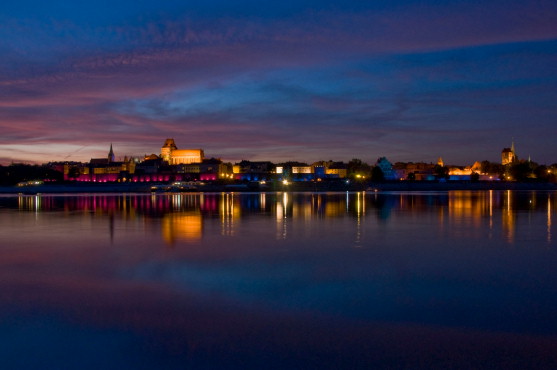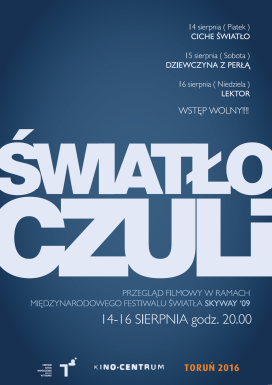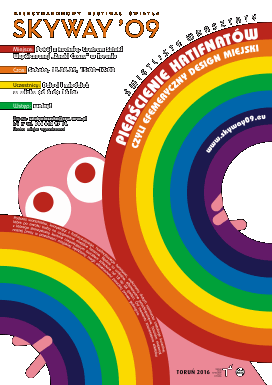Guerrilla Lighting
Firmament

Modyfikując dotychczasowe oświetlenie murów, Światła Partyzanckie (Guerrilla Lighting) pokazują, w jaki sposób kształtując otaczającą nas architekturę można określać naszą tożsamość, wpływać na nasze poczucie bezpieczeństwa i strachu, sprawiać, że to co prozaiczne i codzienne staje się niezwykłe i tajemnicze i na odwrót. W tej wyjątkowej instalacji użyto niebiesko-fioletowych świateł, które przywodzą na myśl kolory nocnego nieba.
Pochodząca z Irlandii grupa architektów, projektantów i artystów szturmem zdobędzie Toruń swoją walką o “dobre oświetlenie”. Instalacja, która odbędzie się przy murach obronnych – Guerrilla lighting (ang. światła partyzanckie) – to wojna wytoczona kiepskiemu oświetleniu, protest przeciwko marnotrawieniu światła. W Guerrilla chodzi o zabawę i wzmacnianie świadomości siły światła. Profesjonalnie zaprojektowane oświetlenie architektoniczne poprawia nocny krajobraz naszych miast, ale wymaga energii elektrycznej. Aby zapewnić właściwą równowagę między korzyściami płynącymi z dobrego oświetlenia a nieodpowiedzialnym wykorzystaniem energii, potrzebna jest kontrola. Ta kontrola powinna również objąć architektoniczną iluminację budynków – takie jest przesłanie instalacji. Autorzy poprzez odpowiednie oświetlenie tworzą efemeryczne, magiczne chwile, które są rejestrowane i później wysyłane do mediów i polityków, aby wymóc działanie przeciw marnotrawieniu światła.
O twórcach
Guerrilla Lighting/Światła Partyzanckie to projekt mający na celu ukazanie potencjału, jaki kryje się w nowoczesnym projektowaniu oświetlenia. Polega on na urządzaniu wyjątkowych demonstracji, podczas których mieszkańcy miasta biorą udział w tworzeniu ulotnych obrazów ze światła, współgrających z miejską architekturą. W projekcie używane są powszechnie dostępne, zwykłe latarki, za pomocą których tworzy się na murach niesamowite wzory. Koncept “partyzantki” narodził się w 2006, w głowie Martina Luptona (obecnie Prezesa Towarzystwa Zawodowych Architektów Oświetlenia – Professional Lighting Design Association). Pierwsze taka akcja odbyła się w listopadzie 2006 w Manchester, następnie “podbite” zostały: Londyn, Glasgow, Birmingham, Dublin, Helsinki, Douglas, Belfast i Cork. Ponad tysiąc partyzantów włączyło się w kampanię, zaś sama inicjatywa została uhonorowana przez środowisko architektów i projektantów nagrodą za Wyjątkowy Projekt (UK Lighting Design 2007) oraz nominacją do nagrody za Wybitne Osiągnięcie (NCE/ACE 2009).
O miejscu instalacji
Mury obronne – to odcinek obwarowań biegnących wzdłuż Wisły – ostatni tak dobrze zachowany ciąg murów obronnych w Toruniu. Pozostałe odcinki (z drobnymi wyjątkami) na przestrzeni XIX w. „padły ofiarą” modernizacji miasta, „otwierania” go i poszukiwania nowych miejsc pod rozwój zabudowy. W najwyższym miejscu (między Bramą Żeglarską i basztą Gołębnik) mur mierzył 8,5 metra wysokości.
By modifying the existing permanent luminaires along the wall, GUERRILLA LIGHTING consider the architecture as a mode of definition, determining the identities of the self and the other, the safe and the dangerous, the mundane and the extraordinary. The choice of a blue-purple gradient reflects the classic colours of the night sky.
Coming from Ireland, a group of architects, designers and artists strike Toruń with their urban war on ‘bad lighting’: Guerrilla Lighting is a protest against wasteful use of light but most of all, about having fun and raising the awareness of the power of light. Professionally designed architectural lighting enhances the nightscape of our cities and towns but requires the use of energy. In order to ensure that a correct balance is achieved between the benefits of good lighting and irresponsible use of energy more control is required, they believe that this control should include the control of architectural lighting of buildings. Guerrilla lighting creates ephemeral and magical moments of quality lighting that are recorded and sent to the media and politicians to instigate action against bad lighting.
About the artists
Guerrilla Lighting raises the awareness of the potential of innovative lighting design by engaging members of the public in the creation of transient urban architectural lighting demonstrations. They use commercially available, handheld rechargeable torches to realise striking designs. The concept was developed in 2006 by Martin Lupton (current President of the Professional Lighting Design Association). The first event took place in Manchester in November 2006, with subsequent ‘strikes’ on London, Glasgow, Birmingham, Dublin, Helsinki, Douglas, Belfast and Cork. Over one-thousand Guerrillas have joined their campaign, and Guerrilla Lighting has been recognised within the architectural design profession with an award for Special Project (UK Lighting Design 2007) and nomination for Outstanding Achievement (NCE/ACE 2009).
About the site
The fortifications located along the bank of the Wisła river are the last fragment of Toruń city walls to be so well preserved. All the rest (with a few exceptions) was wiped out as a result of the modernization and ‘opening’ of the town, as well as the search of new plots for development that took place during the XIX century. In the past, the tallest fragment of the wall (from the Sailors Gate to Baszta Gołębnik – the Dovecot Tower) measured 8.5 metres.



